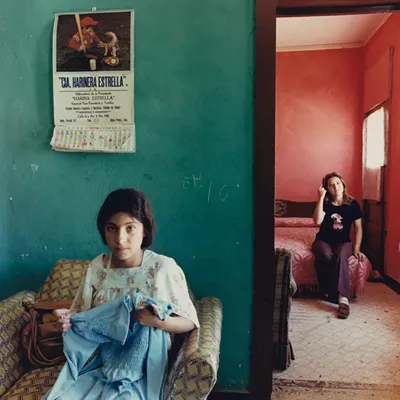On Tuesday, the tally of Americans dead in Iraq passed 1,000. On Saturday, the nation marked the third anniversary of the deaths of the thousands who perished on Sept. 11. And here in Tucson, less catastrophically, the artist Kate Breakey opened her one-person show, Small Deaths, at the Tucson Museum of Art.
Unlike the well-publicized deaths that dominated the news, the small deaths that Breakey memorializes in her 13 giant, painted photographs are not ones that anyone bothers to mourn much. They are the deaths of the Sonoran Desert's own--the plants and animals who have withered and died in the fiery blast of desert heat.
Growing up on a farm in Australia, Breakey was one of those kids who was always trying to rescue fledglings fallen from the nest. Transplanted first to Cambridge, Mass., then to Austin and finally to Tucson in 1998, nowadays Breakey roams the desert near her Tucson Mountains home in search of creatures to save. More often than not, the creatures are past earthly salvation, but Breakey gives them an artistic immortality. She picks up the little corpses of birds, lizards, bunnies and flowers, and brings them home, where they become the starting point for an art of a complicated beauty.
In her studio, she arranges the animals and plants for formal memento mori portraits, not unlike those the Victorians made of newly dead children, lying transcendent in clean, white clothes and sheets. Breakey doesn't photograph the animal's whole body, just the head and chest--classic portrait style--against a plain, abstracted background. This startling composition transforms the little critters into something to be reckoned with. Nearly filling the frame of the big work, "Otus Asio, Eastern Screen Owl" has the dignity of an elder statesman. A flamboyant dead cardinal, pictured in a side view, is as solemn and self-important as a businessman.
This impression is heightened by the pictures' monumentality. Breakey blows the photos up to 32 by 32 inches, enlarging her creatures to a size that insists on acknowledgment. You can't ignore a lizard corpse that's almost three feet tall. It's as big as we are. Forget about human-animal hierarchy. These creatures are our equals.
But even after all this work, Breakey is still not done. A trained painter as well as photographer, Breakey mixes her media, lavishing her dead flowers and animals with paint, sometimes giving them a brilliance that they never had in life. An aura of cerulean blue glows around the cardinal's crimson feathers and yellow beak. The blazing petals of the flower "Galliardia pulchella, Indian blanket" rocket out like yellow sunbeams into a brilliant blue background, bluer than any real-life Tucson sky. "Pediocactus simpsoni, Simpson's hedgehog cactus" is florid in fuchsia, against a backdrop of rusty brown.
Some pictures are colored more somberly, in keeping with their depiction of death. The desert cottontail is softly colored in grays and ochres, its limp paws spread out against a gray-brown backdrop that mimics the desert floor.
Breakey has worked as a scientific illustrator in the past, and a scientist's taxonomic precision also plays a part in her art. Each specimen is labeled in a delicate cursive, the names spelled out at the bottom of the picture in Latin and in English. And she makes sure to highlight every detail of her subjects. She takes colored pencils and painstakingly draws in every bit of down, every tuft of fur. In "Melanerpes uropygialis, Gila Woodpecker II," every feather on the glorious black-and-white wings of the Gila woodpecker is recorded and celebrated. The bird turns its head to one side, and its patterned wings drape below it like a royal cape, covering the body like a shroud.
Breakey has exhibited works from this longtime series before, at Etherton Gallery and in her book, Small Deaths, published by the University of Texas Press. But somehow, lined up in a row, one portrait of death after another, this week they seem especially timely.
After Sept. 11, The New York Times published photographs of nearly all of the 3,000 people who had died in the terrorist attacks. Last week, the paper did the same for the Americans who have lost their lives in Bush's calamitous misadventure in Iraq. Spread over three pages, row on row, were 1,002 portraits, the young faces of soldiers, marines, sailors and airmen and -women who will never grow old. The publication of the pictures rescues each one from the anonymity of the death tallies. Each one has a name, and each one is an individual. One wears a military cap jauntily, another by the book; still another has his civilian hair hanging freely. Some smile crookedly or confidently, while others gaze sternly into a future that would turn out to be heartbreakingly short.
A lizard dying a natural death in the Sonoran Desert is in no way equivalent to a teenager getting blown up in the sands of Iraq. But in a way, the newspaper's act of salvage has parallels to Breakey's work, and carries a similar message. Every life matters. And so does every death.













